35
First apple tree planted by Father Pandosy at the Mission siteCirca 1935
Father Pandosy Mission, Okanagan Mission, British Columbia
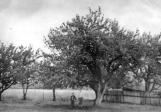 Credits:
Credits:Kelowna Public Archives #3782
36
Father Pandosy died on February 6th 1891, at the age of 67 and was buried across the road from his church, just as the new Benvoulin townsite was being developed and more settlers were arriving in the area. The Mission and the community around it continued to flourish after Pandosy's death. The farm at the Mission grew close to 2,450 acres. The Mission became the Catholic Church's headquarters for the area from the U.S. border in the south to Fort Kamloops in the north, the Similkameen Valley in the east to the Nicola Valley and Merritt in the west. When the CPR completed its transcontinental line in 1895, Kamloops became the nearest rail connection, so the Oblates moved their headquarters to the St. Louis Mission in Kamloops. The Okanagan Mission and all related properties were sold to Father Eumelin and other members of his family in 1896 (Eumelin was not an Oblate, but continued to run the Mission as its priest until 1902). In 1902, the original Mission of the Immaculate Conception was officially closed. The land went on to be purchased by the Kelowna Land and Orchard Company around 1904, then subdivided and sold as prime orchard sites. The subdivision of land opened up the area to intensive agriculture which included fruit orchards and tobacco farms.37
De Pfyffer family walking through their fruit orchardCirca 1910
Okanagan Mission, British Columbia
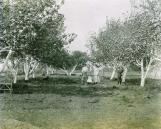 Credits:
Credits:Kelowna Public Archives #3711
38
Father Pandosy Mission Heritage Site after restorationCirca 1960s
Father Pandosy Mission, Okanagan Mission, British Columbia
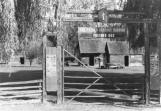 Credits:
Credits:Kelowna Public Archives #11048
39
In 1894 Louis Holman introduced the growing of tobacco on the old Lequime place across from Leqime's blacksmith shop. This was considered part of the first 'tobacco bubble' in the area. The next 'tobacco bubble' was created by the British North American Tobacco Company (BNATCO) in 1912. This drew many local farmers into a whirlwind with its promises of a huge and lucrative tobacco industry, where tobacco would become the primary crop in the area. At one time there were eight tobacco farms in the Benvoulin area alone.The company built a large cigar factory (on Ellis Street) and leased and/or purchased farmland in the Benvoulin area and built considerable infrastructure, including a number of tobacco-curing barns. Local farmers planted over 500 acres in tobacco in 1913. At that time tobacco was grown extensively on both sides of Benvoulin Road and in other fields at Okanagan Mission as well as a site later occupied by the old Kelowna Secondary School on Harvey Avenue.
The Company went bankrupt in 1914, as a result of bad business decisions and embezzlement by a company officer. There was a tobacco revival in the area in the 1920s, until the Great Depression. Many of the tobacco barns were repurposed to store hay or serve as diary barns.
40
Tobacco harvesting at the Casorso farm in the Benvoulin areaCirca 1919
Benvoulin, British Columbia
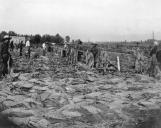 Credits:
Credits:Kelowna Public Archives #3677
41
The McEachern tobacco barn, later owned by the McFarlane familyCirca 1973
Benvoulin, British Columbia
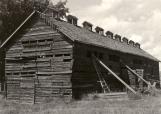 Credits:
Credits:Kelowna Public Archives #3685
42
There were many new families who bought MacKay's subdivided acreages in the Benvoulin area and became very involved in the local community. Some of these settlers included the: Munsons, Reids, Days, Hardys and Petermans. A few of these early settler's descendants are still farming on the land originally owned by their grandparents. Even with MacKay's planned townsite and his donation of land towards a new Presbyterian church to encourage development in his town centre, the Benvoulin area would remain largely an agricultural area where early settlers would come and buy land and plant orchards.43
Portrait of early Benvoulin pioneer familiesCirca 1890s-1900
Benvoulin, British Columbia
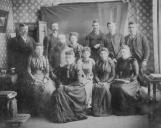 Credits:
Credits:Stephen Munson
Central Okanagan Heritage Society Fonds
44
Robert and Eliza Munson with childrenCirca 1890
Benvoulin, British Columbia
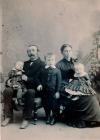 Credits:
Credits:Stephen Munson
Central Okanagan Heritage Society Fonds
45
William Dagilish Hobson and his dogCirca 1920s
Okanagan Mission, British Columbia
 Credits:
Credits:Hobson Family Collection (Robert Hobson)
46
The Day family ancestors arrived in the area in 1899 and a large acreage in Benvoulin is still farmed by family today (2012). E.A. Day (English parentage from Utah) came to the Okanagan and became friends and brother-in-law with David Lloyd-Jones, a carpenter. They went into the sawmill business together in Kelowna. Day was also the foreman at the Lequime estate, after Frank Conklin. E.A. Day bought property in Kelowna and in the Benvoulin district (currently known as the Day farm) and built a home for his seven children after the death of his young wife, Mary Jane.Archie and Julia Hardy arrived in the Okanagan in 1889 and lived on a farm on Benvoulin Road (where Orchard Park is now). Archie was a coachman for Lord Aberdeen. In 1903, Archie Hardy along with Alex Reid put up money to reopen the Benvoulin School. Archie and Julia contributed financially and physically to the construction of the Bethel Presbyterian Church. Archie was an organist at the church as well.
47
Mary Peterman standing near the house on the Peterman farmCirca 1920s
Benvoulin, British Columbia
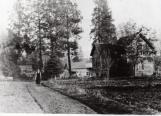 Credits:
Credits:Peterman Family Collection (Doug Arthur)
48
Portrait of the Reid family shortly after they arrived in BenvoulinCirca 1903
Benvoulin, British Columbia
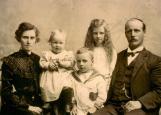 Credits:
Credits:Reid Family Collection (Allen Reid)